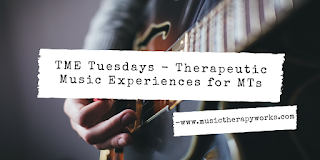TME Tuesday:
Therapeutic Music Experiences (TMEs) are my foundation for everything that I do in my music therapy sessions. I do not make formal session plans. I haven't really done that since I had to as a practicum student way, WAY back, so I have to have something to organize my thoughts and experiences for my clients. My TME plans do that for me - they organize me and allow me to provide robust treatment for my clients in sessions.
(As I am writing this, I am hoping that the recent font issues that I have had have been rectified.)
I have kept the basic format of writing the things that I do in sessions that I learned way, WAY back. I start off with a purpose statement - this is where I brainstorm all of the goals that will be addressed by the TME. I rarely write clinical objectives in this area because I believe that objectives have to come with the client - it is my job as the therapist to make the TME match what the client needs. Instead of trying to anticipate future objectives, I look at the goal areas that are possible with my TMEs.
There are so many things that can be addressed during one musical experience. I am always challenged to find as many as I can, but I also accept that there are things that I will miss. TMEs are never completely finished!
Here is a TME Tuesday post from March 27, 2018. Search the label, TME Tuesday, to see more of these posts from years past if you are interested in some of my ideas. Also, consider subscribing to my monthly sing about songs mini edition if you would like a monthly dose of session planning ideas and TMEs. There are new products coming, so stay tuned to this blog or to my website.
I love writing negative
emotion songs - I guess that's what I'll call them. It's a song that
recognizes an emotion or situation that is not always the most
acceptable in society and acknowledges such emotion or situation. I
often sing about bad friends, feeling frustrated, and nasty food. I have
several "I Like" therapeutic music experiences (TMEs) that I've written
over the years, but I find that my students request the "I Don't Like"
TMEs more than the others.
Here's one. It is also a
bit of a complaining song, which I really like right now! If you'd be
interested in the sheet music, drop me a comment, and I'll send you a
link!
|
Melody
|
Pitch
|
Rhythm
|
Dynamics
|
Harmony
|
|
Minor key, mostly downward to illustrate frustration
musically
|
Variable to accommodate group members’ preferences
|
Macrobeat
|
Variable to accommodate group members’ preferences and
needs (sensory and attention needs)
|
Minor
|
|
Form
|
Tempo
|
Timbre
|
Style
|
Lyrics
|
|
Variable – due to improvised nature of lyrics and
experience
|
Variable to accommodate group members’ preferences and
needs (sensory and attention needs)
|
Variable to accommodate group members’ preferences and
needs (sensory and attention needs)
|
None
|
Variable to accommodate group members’ preferences and
needs (sensory and attention needs)
|
- Start discussion about opinions and facts


Comments
Post a Comment